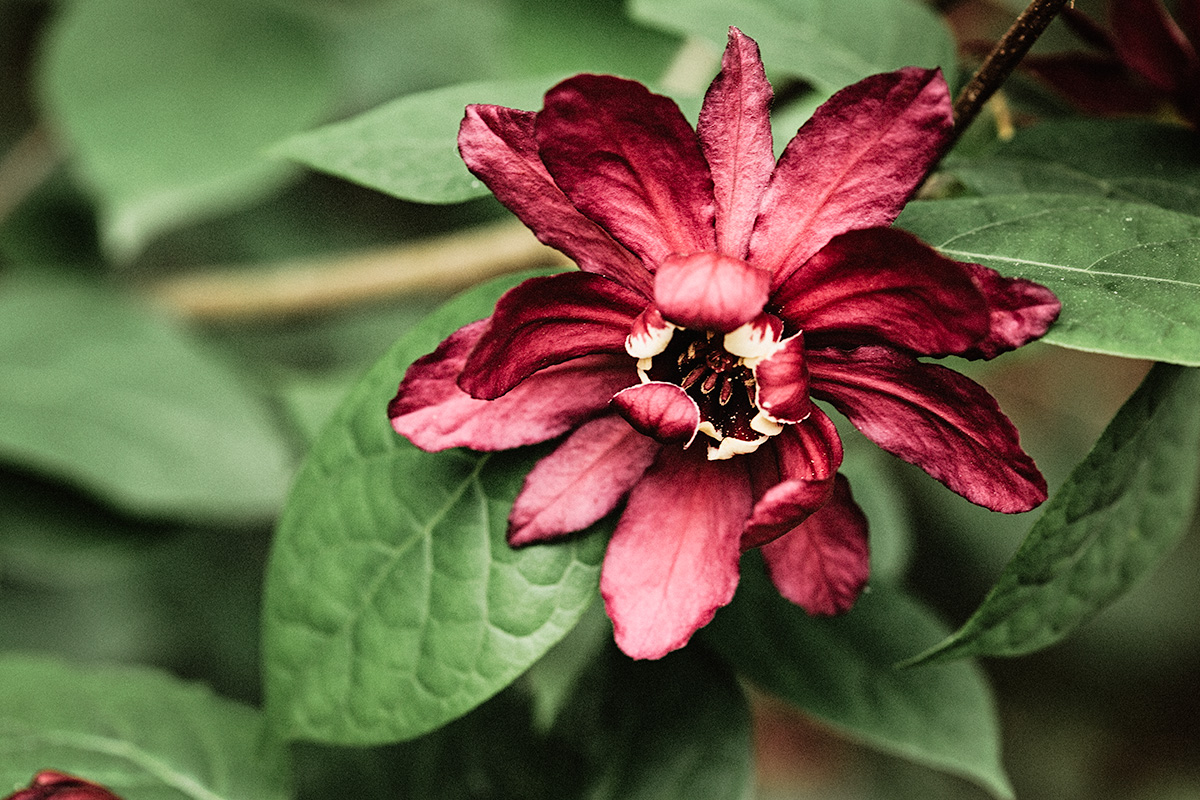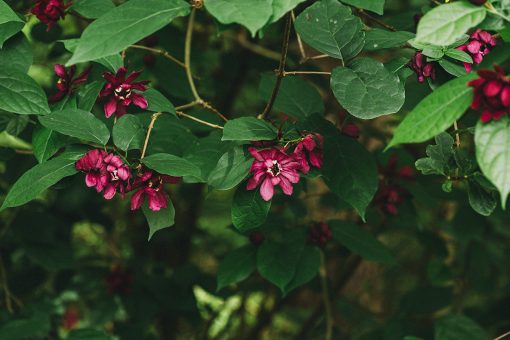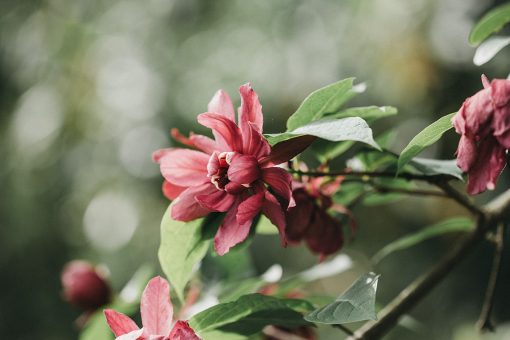First published in the May 2024 edition of Grapevine, the newsletter for Yamhill County Master Gardeners.
An Old Sweet Shrub Keeps Georgia on My Mind
It was a once-in-a-lifetime road trip from Oregon to Georgia. Over 3,000 miles of vast and changing landscapes. In the rearview were giant saguaro, arching saltcedar, pistachio groves, and bald cypress. The signature specimens. But Georgia springtime held a surprise. Below the impressive magnolia and sweet gum trees bloomed an often overlooked beauty. Calycanthus floridus, a native shrub to Georgia with ties to home.
Thousands of wine red blossoms lined a creek and filled the understory in Roswell Area Park. Common names abound. Eastern sweetshrub, Carolina allspice, Sweet Bubby Bush, Sweet Betsy, strawberry shrub, and more. The species is native from southeast Pennsylvania to the Florida panhandle. The common sweetshrub produces heavily scented flowers and aromatic leaves, twigs and bark.
This gem of Georgia is a gardener’s dream. Grown in zone 4 to 9, Calycanthus floridus is resistant to disease and insect problems. OSU declares that it is not considered a “delectable salad” by deer. The deciduous shrub adapts to many soils and light conditions. It is a good replacement for Daphne, bush honeysuckle, and mock orange. The flowers grow on old wood April through July and compare to lotus and magnolia blossoms.
After researching a little more, the sweetshrub story took a turn toward home. There is an underrated West Coast species, Calycanthus occidentalis. Common names include Western or California sweetshrub-spicebush-allspice. It is rarely grown outside its native haunts (and not grown all that much there, either). The native-to-Oregon version grows a bit taller. Its flowers are larger and tend toward a true red. Beetles in the Nitidulidae family pollinate both species.
Describing the scent of the bruised bark is up to the nose of the beholder. Green apple, cinnamon, or even gin and tonic. The scent and the flowers can be tropical or nonexistent. Purchasing a transplant while in bloom and fragrant, is a good idea.
The Cherokee used the Carolina allspice for a root tea to treat urinary and bladder issues. A cold bark tea served as eye drops for persons with failing eyesight. Bark ooze soothed skin sores. A root and leaf tea helped for hives.
For many though, the Eastern sweetshrub flowers are simply a nostalgic scent. Hints of pineapple, strawberry and banana earned it the name Bubby bush – a politer version of booby bush. This refers to the practice of women crushing the flowers and placing them in their cleavage. The leaves, bruised twigs, and flowers were often dried for potpourri. Perfuming Grandma’s dresser drawers.
Unfortunately, the California allspice flowers are less fragrant. The bruised twigs compared to a sniff of an “old wine barrel.”
Native plants often are the ones ignored in our yards and gardens. While photographing the sweetshrub flowers – exotic to an Oregonian – a local asked for the name. He had never noticed the flowers before. We chatted and smelled the bruised bark. The smell to my nose is without question gin and tonic. The passerby declared he would be adding the “new find” to his yard. I will be in search of the Western sweetshrub for mine.
Carolina sweetshrub deserves a place in our understory and also in our U.S. history books. President George Washington enjoyed the sweet scent and planted the shrub at Mt. Vernon. In May of 1786, Washington’s diary records that he “Planted or rather transplanted from the Box sent me by Colo. Wm. Washington of So. Carolina 6 of the Sweet scented, or aromatic shrub in my Shrubberies, on each side the Serpentine walks on this (or East) side of the Garden gate.”
If you’ve enjoyed this post then please consider subscribing to my mailing list. You’ll get a quick note whenever something new is on my blog. Sign up here.
Article update: Since writing this piece I have spotted sweetshrub only once in Oregon. It was spilling over a Eugene fence. But it appears that Lux Perennials Nursery in Portland has the fragrant Calycanthus ‘Aphrodite’ in their display garden and for sale. I can’t wait to visit and grab my own “Sweet Bubby Bush.”
Article Resources:
Oregon State University: https://landscapeplants.oregonstate.edu
Native American Ethnobotony Database: http://naeb.brit.org/uses/7819/
George Washington’s Mt. Vernon: https://www.mountvernon.org
Horticulture Magazine: https://www.hortmag.com/plants/all-about-sweetshrub
The University of Texas at Austin Lady Bird Johnson Wildflower Center: https://www.wildflower.org



